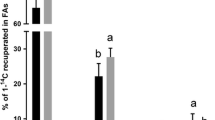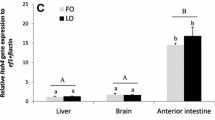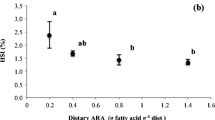Abstract
Duplicate groups of Atlantic salmon parr were fed diets containing either fish oil (FO), rapeseed oil (RO), linseed oil (LO) or linseed oil supplemented with arachidonic acid (20:4n-6; AA) (LOA) from October (week 0) to seawater transfer in March (week 19). From March to July (weeks 20–34) all fish were fed a fish oil-containing diet. Fatty acyl desaturation and elongation activity in isolated hepatocytes incubated with [1-14C]18:3n-3 increased in all dietary groups, peaking in early March about one month prior to seawater transfer. Desaturation activities at their peak were significantly greater in fish fed the vegetable oils, particularly RO, compared to fish fed FO. Docosahexaenoic acid (22:6n-3:DHA) and AA in liver and gill polar lipids (PL) increased in all dietary groups during the freshwater phase whereas eicosapentaenoic acid (20:5n-3; EPA) increased greatly in all groups after seawater transfer. The AA/EPA ratio in tissue PL increased up to seawater transfer and then decreased after transfer. AA levels and the AA/EPA ratio in gill PL were generally higher in the LOA group. The levels of 18:3n-3 in muscle total lipid were increased significantly in the LO, LOA and, to a lesser extent, RO groups prior to transfer but were reduced to initial levels by the termination of the experiment (week 34). In contrast, 18:2n-6 in muscle total lipid was significantly increased after 18 weeks in fish fed the diets supplemented with RO and LO, and was significantly greater in the FO and RO groups at the termination of the experiment. Gill PGF production showed a large peak about two months after transfer to seawater. The production of total PGF post-transfer was significantly lower in fish previously fed the LOA diet. However, plasma chloride concentrations in fish subjected to a seawater challenge at 18 weeks were all lower in fish fed the diets with vegetable oils. This effect was significant in the case of fish receiving the diet with LOA, compared to those fed the diet containing FO. The present study showed that during parr-smolt transformation in Atlantic salmon there is a pre-adaptive increase in hepatocyte fatty acyl desaturation/elongation activities that is controlled primarily by environmental factors such as photoperiod and temperature but that can also be significantly modulated by diet. Feeding salmon parr diets supplemented with rapeseed or linseed oils prevented inhibition of the desaturase activities that is induced by feeding parr diets with fish oils and thus influenced the smoltification process by altering tissue PL fatty acid compositions and eicosanoid production. These effects, in turn, had a beneficial effect on the ability of the fish to osmoregulate and thus adapt to salinity changes.
Similar content being viewed by others
References
Ackman, R.G. 1980. Fish lipids, part 1. In : Advances in Fish Science and Technology. pp. 87–103. Edited by J.J. Connell. Fishing News Books, Farnham, U.K.
Ackman, R.G. and Takeuchi, T. 1986. Comparison of fatty acids and lipids of smolting hatchery-fed and wild Atlantic salmon Salmo salar . Lipids 21: 117–120.
Bell, J.G. 1996. Influences of dietary polyunsaturated fatty acid composition and eicosanoid production in Atlantic salmon (Salmo salar ). Doctor of Philosophy Thesis, University of Stirling, Scotland.
Bell, J.G., Dick, J.R., McVicar, A.H., Sargent, J.R. and Thompson, K.D. 1993. Dietary sunflower, linseed and fish oils affect phospholipid fatty acid composition, development of cardiac lesions, phospholipase acivity and eicosanoid production in Atlantic salmon (Salmo salar ). Prostaglandins, Leukotrienes Essent. Fatty Acids 49: 665–673.
Bell, J.G., Tocher, D.R., Farndale, B.M., Cox, D.I., McKinney, R.W. and Sargent, J.R. 1997. The effect of dietary lipid on polyunsaturated fatty acid metabolism in Atlantic salmon (Salmo salar ) undergoing parr-smolt transformation. Lipids 32: 515–525.
Bell, J.G., Tocher, D.R. and Sargent, J.R. 1994. Effect of supplementation with 20:3(n-6), 20:4(n-6) and 20:5n-3 on the production of prostaglandins E and F of the 1-, 2-and 3-series in turbot (Scophthalmus maximus ) brain astroglial cells in primary culture. Biochim. Biophys. Acta 1211: 335–342.
Bell, M.V., Henderson, R.J., Pirie, B.J.S. and Sargent, J.R. 1985. Effects of dietary polyunsaturated fatty acid deficiencies on mortality and gill structure in the turbot Scophthalmus maximus . J. Fish Biol. 26: 181–191.
Bolgova, O.M. and Shchurov, I.L. 1987. Adaptive changes in fatty acid Spectra in tissue lipids of wild and cultivated salmon Salmo salar during the parr-smolt period. Zh. Evol. Biokhim. Fiziol. 23: 211–215.
Brenner, R.R. 1981. Nutritional and hormonal factors influencing desaturation of essential fatty acids. Prog. Lipid Res. 20: 41–47.
Brown, J.A. and Bucknall, R.M. 1986. Antidiuretic and cardiovascular actions of PGE2in the rainbow trout Salmo gairdneri . Gen. Comp. Endocrinol. 61: 330–337.
Christie, W.W. 1982. Lipid Analysis 2nd Edition. Pergamon Press, Oxford. pp. 207.
Di Constanzo, G., Duportail, G., Florents, A. and Leray, C. 1983. The brush border membrane of trout intestine: Influence of its lipid composition on ion permeability, enzyme acitvity and membrane fluidity. Mol. Physiol. 4: 279–290.
Duston, J. and Saunders, R.L. 1990. Control of the timing of smoltification in Atlantic salmon: Endogenous rhythms and environmental factors. In : Proc. of Canada-Norway Finfish Aquaculture Workshop. pp. 99–105. Edited by R.L. Saunders. Can. Tech. Rep. Fish. Aquat. Sci., Canada.
Folch, J., Lees, M. and Sloane-Stanley, G.H. 1957. A simple method for the isolation and purification of total lipids from animal tissues. J. Biol. Chem. 226: 497–509.
Folmar, L.C. and Dickhoff, W.W. 1980. The parr-smolt transformation (smoltification) and seawater adaptation in salmonids: A review of selected literature. Aquaculture 21: 1–37.
Gaignon, J.-L. and Quemener, L. 1992. Influence of early thermic and photoperiodic control on growth and smoltification in Atlantic salmon (Salmo salar ). Aquat. Living Resour. 5: 185–195.
Gerbi, A., Zerouga, M., Debray, M., Durand, G., Chanez, C. and Bourre, J-M. 1994. Effect of fish oil diet on fatty acid composition of phospholipids of brain membranes and on kinetic properties of Na+, K+-ATPase isoenzymes of weaned and adult rats. J. Neurochem. 62: 1560–1569.
Hoar, W.S. 1976. Smolt transformation: Evolution, behaviour and physiology. J. Fish Res. Board Can. 33: 1234–1252.
Li, H.-O. and Yamada, J. 1992. Changes of the fatty acid composition in smolts of masu salmon (Oncoryhnchus masou ), associated with desmoltification and seawater transfer. Comp. Biochem. Physiol. 103A: 221–226.
Lowry, O.H., Rosebrough, N.J., Farr, A.L. and Randall, R.J. 1951. Protein measurement with the folin phenol reagent. J. Biol. Chem. 193: 265–275.
McCormick, S.D. 1995. Loss of smolt characteristics in hatcheryand stream-reared Atlantic salmon. In : High Performance Fish. pp. 51–56. Edited by D.D. Mackinlay. American Fisheries Soc.
Mustafa, T. and Srivastava, K.C. 1989. Prostaglandins (eicosanoids) and their role in ectothermic organisms. Adv. Comp. Environ. Physiol. 5: 157–207.
Sargent, J.R., Henderson, R.J. and Tocher, D.R. 1989. The lipids. In : Fish Nutrition. pp. 154–218. Edited by J. E. Halver. Academic Press, New York.
Sheridan, M.A., Allen, W.V. and Kerstetter, T.H. 1985. Changes in the fatty acid composition of steelhead trout, Salmo gairdnerii Richardson associated with parr-smolt transformation. Comp. Biochem. Physiol. 80B: 671–676.
Spector, A.A. and Yorek, M.A. 1985. Membrane lipid composition and cellular function. J. Lipid Res. 26: 1015–1035.
Tocher, D.R., Bell, J.G., Dick, J.R. and Sargent, J.R. 1997. Fatty acyl desaturation in isolated hepatocytes from Atlantic salmon (Salmo salar ): Stimulation by dietary borage oil containing γ -linolenic acid. Lipids 32: 1237–1247.
Tocher, D.R., Sargent, J.R. and Frerichs, G.N. 1988. The fatty acid compositions of established fish cell lines after long-term culture in mammalian sera. Fish Physiol. Biochem. 5: 219–227.
U.S. National Research Council 1993. Nutrient Requirements of Fish, Washington D.C. National Academy Press.
Van Praag, D., Farber, S.J., Minkin, E. and Primor, N. 1987. Production of eicosanoids by the killifish gills and opercular epithelia and their effect on active transport of ions. Gen. Comp. Endocrinol. 67: 50–57.
Wagner, H.H. 1974. Photoperiod and temperature regulation of smolting in steelhead trout (Salmo gairdneri ). Can. J. Zool. 52: 219–234.
Wales, N.A.M. 1988. Hormone studies in myxine glutinosa: effects of the eicosanoids arachidonic acid, prostaglandin E1, E2, A2, F2α, thromboxane B2and of indomethacin on plasma cortisol, blood pressure, urine flow and electrolyte balance. J. Comp. Physiol. 158B: 621–626.
Wedermeyer, G.A., Saunders, R.L. and Clarke, W.C. 1980. Environmental factors affecting smoltification and early marine survival of anadromous salmonids. Mar. Fish. Rev. 42: 1–14.
Wilson, R. and Sargent, J.R. 1992. High resolution separation of polyunsaturated fatty acids by argentation thin-layer chromatography. J. Chromatogr. 623: 403–407.
Woyewoda, A.D., Shaw, S.J., Ke, P.J. and Burns, B.G. 1986. Recommended laboratory methods for assessment of fish quality. Canadian Technical Report of Fisheries and Aquatic Sciences No. 1448, 143 pp.
Author information
Authors and Affiliations
Rights and permissions
About this article
Cite this article
Tocher, D., Bell, J., Dick, J. et al. Polyunsaturated fatty acid metabolism in Atlantic salmon (Salmo salar) undergoing parr-smolt transformation and the effects of dietary linseed and rapeseed oils. Fish Physiology and Biochemistry 23, 59–73 (2000). https://doi.org/10.1023/A:1007807201093
Issue Date:
DOI: https://doi.org/10.1023/A:1007807201093




